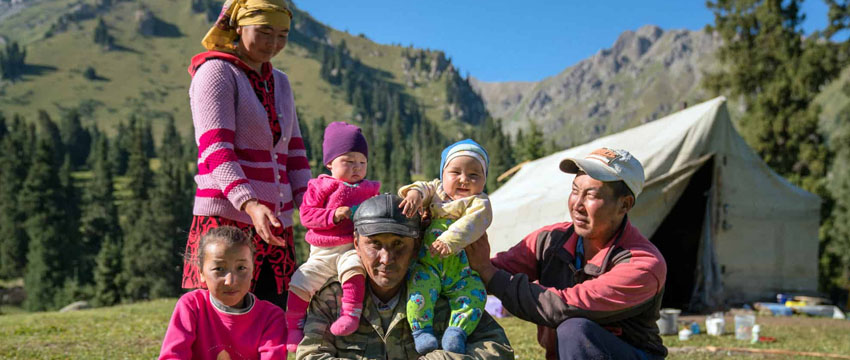The locals of Kyrgyzstan, known as the Kyrgyz people or Kirgiz, Kirghiz, Kara-Kyrgyz people are easy to go and offer a warm welcome to all its visitors. However, it is always good to know about people living in the area, their survival means, food and clothing habits before you plan your vacation to that place, to avoid any sort of regional offence.
Origin Of The Kyrgyz Cult
The name Kirghiz dates back to around the 8th century. The Kyrgyz people originated in the Yenisley valley of Siberia and migrated to the area that is occupied by modern-day Kyrgyzstan. The major reason for the migration were the Mongols. The Kyrgyz people believed that the name Kyrgyz meant ‘forty girls’. They are believed to have descended from the forty tribes.
Majority of the Kyrgyz people live in the region of the Kyrgyz Republic or Kyrgyzstan. A large Kyrgyz population also lives in China, Afghanistan, Uzbekistan and Tajikistan.
Linguistic Affiliation
Kyrgyz is the language of the Turks, and very closely related to Kazak. It is unanimously understandable by both Kazak and Uzbek. However, the pronunciation in the northern region of Kyrgyzstan varies from that spoken in the southern provinces.
The children in Kyrgyzstan schools study Kyrgyz, Russian, and English.
Ethnic Relation Of The Kyrgyz People-
Kyrgyzstan is known to be an ethnically diverse country. The diversity has often led to ethnic clashes among different groups. However, the Kyrgyz people unlike the Russians and the Uzbeks are not morally corrupt. At some places, smaller groups like the Dungans and the Uighurs claim that there is discrimination by the Kyrgyz people.
Urbanism, Architecture, And The Use Of Space
People in Kyrgyzstan did not have an established architecture prior to Russian colonialism. All the government and urban architecture were built in the Soviet style. The cities were designed in a way to accommodate parks and plazas filled with benches facing the monuments that had Soviet achievements encrypted on them.
Housing in Kyrgyzstan consisted of large apartment blocks. Apart from this, the Kyrgyz bazaars can be found in all sizes grouped in a way such that the same type of products are sold side by side.
Food Of Kyrgyz People In Daily Life-
The common dishes of the people in Kyrgyzstan includes-
- Manti- small dumplings filled with onion and sometimes meat or pumpkin.
- Lagman- Hand rolled noodles stewed with vegetables and meat.
- Plov-Rice fried with carrots and garnished with meat
- Ashlam-Foo- Cold noodles topped with stewed vegetables and pieces of frozen cornstarch to make a spicy mixture.
- Pelmeni- Is a Russian dish of stewed meat dumplings.
- Samsa- Stuffed pastries with meat or pumpkin.
Kyrgyz people do not eat pork, unlike the Russians who stay in Kyrgyzstan. Kyrgyz people eat mutton, chicken, beef, turkey and goat. Lagman and Manti is the staple diet of northern Kyrgyzstan while plov is eaten every day by the southern population.
Classes And Castes Amidst Kyrgyzstan People
The economic hardships faced during independence resulted in a very small upper class and a large number of lower class population. Politicians and community leaders are the majority constitutes of the upper class.
Symbols Of Social Stratification Of Kyrgyzstan People
You are rich and belong to the upper-class class in Kyrgyzstan if you speak Russian, have a two-storey mansion, a BMW or Mercedes and you are dressed in western clothes.
Not knowing to speak Russian is considered as a sign of the lower class status.
Kyrgyzstan Children-
The Kyrgyzstan people teach their children to stay quiet. Children are not supposed to attend parties and social gatherings so that they do not disturb the guests. Girls are expected to take care of household activities beginning from the age of six or seven. Boys in Kyrgyzstan are considered to be rowdy and are therefore not a part of household chores.
However, education is mandatory for both boys and girls equally and from an early age itself. Public schools in Kyrgyz towns and villages offer education till the eleventh grade.
